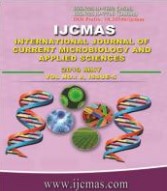


 National Academy of Agricultural Sciences (NAAS)
National Academy of Agricultural Sciences (NAAS)

|
PRINT ISSN : 2319-7692
Online ISSN : 2319-7706 Issues : 12 per year Publisher : Excellent Publishers Email : editorijcmas@gmail.com / submit@ijcmas.com Editor-in-chief: Dr.M.Prakash Index Copernicus ICV 2018: 95.39 NAAS RATING 2020: 5.38 |
Experiments were conducted at Sartingal farm of Regional Horticulture Research Sub- station (RHRSS) Bhaderwah, Doda, SKUAST-Jammu in randomized block design with eight treatments replicated thrice to assess the losses caused by economically important diseases of pea viz., Ascochyta blight and powdery mildew of pea (Pisum sativum L.). Eight different fungicides and bioagents evaluated as foliar spray, recorded significant reduction against ascochyta blight and powdery mildew disease incidence with a concomitant significant increase in yield over control. Among the treatments, foliar spray with Hexaconazole @ 0.1% sprayed twice at 15 days interval was most effective in reducing the disease severity of Ascochyta blight (10.65%) and powdery mildew (8.83%). Percent reduction in disease incidence over control (42.08% Ascochyta blight and 37.66% powdery mildew) was 74.69% and 76.55% respectively in Ascochyta blight and powdery mildew. Accordingly pea yield was also highest in this treatment (99.78 q/ha) which recorded 134.83% increase in pea yield over check (42.49 q/ha). This was followed by Carbendazim @ 0.1% that recorded the disease severity of Ascochyta blight (12.74%) and powdery mildew (16.16%) and pea yield of 74.00 q/ha.
 |
 |
 |
 |
 |